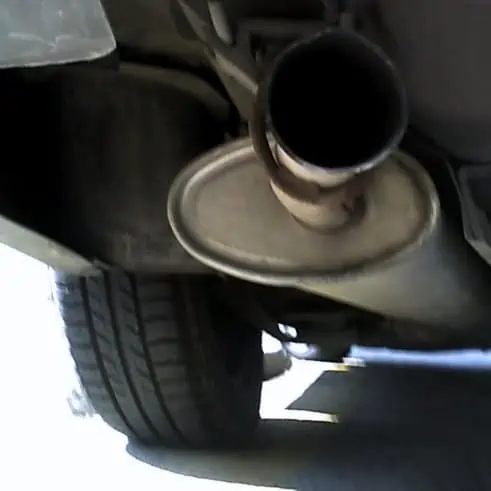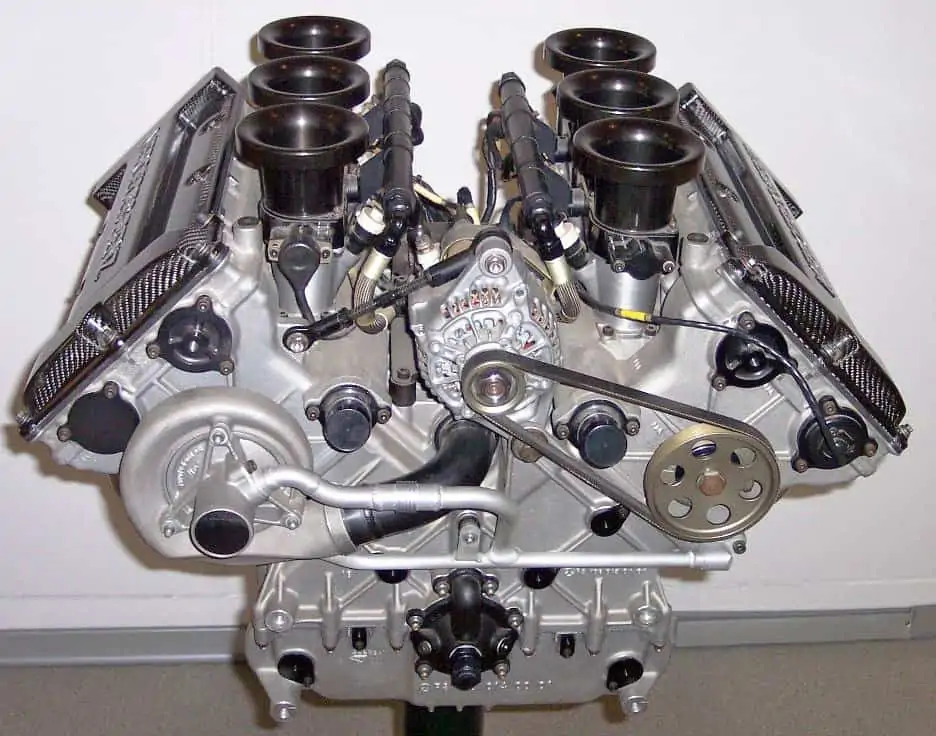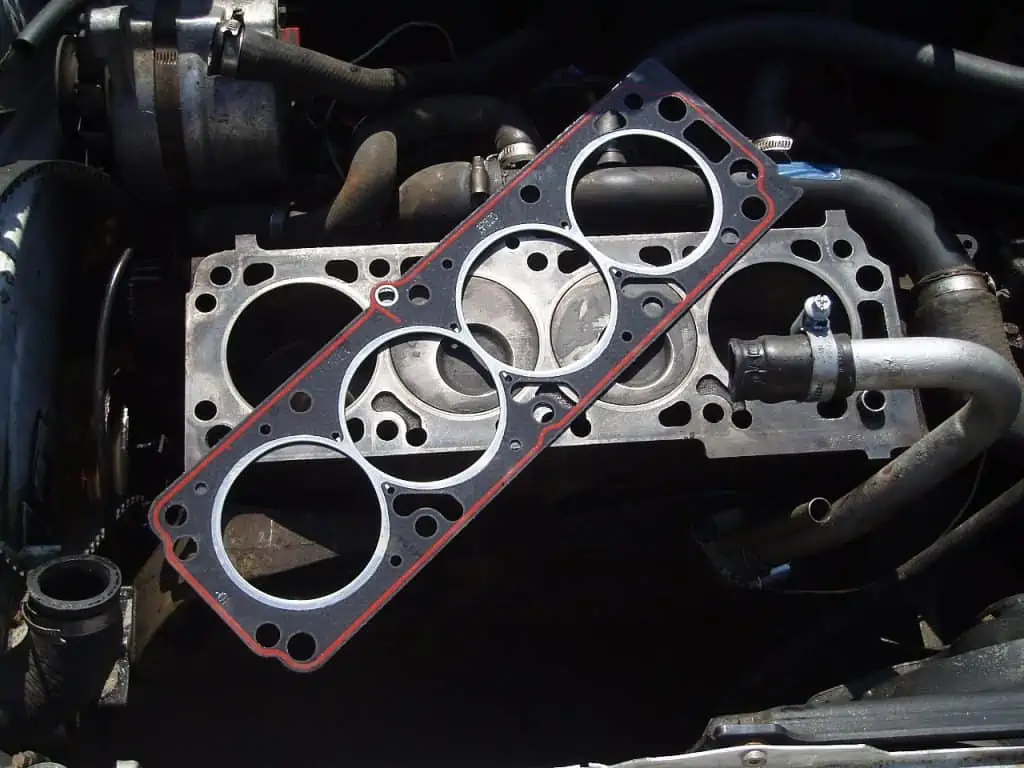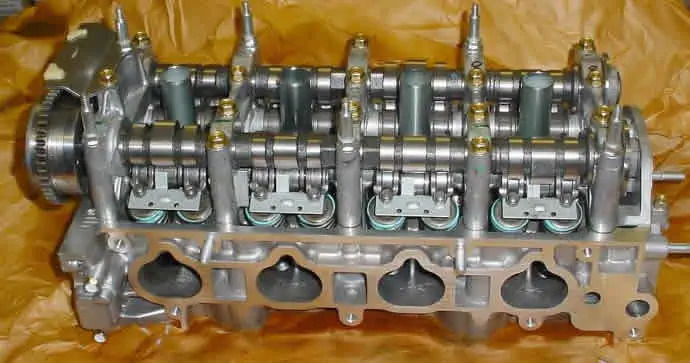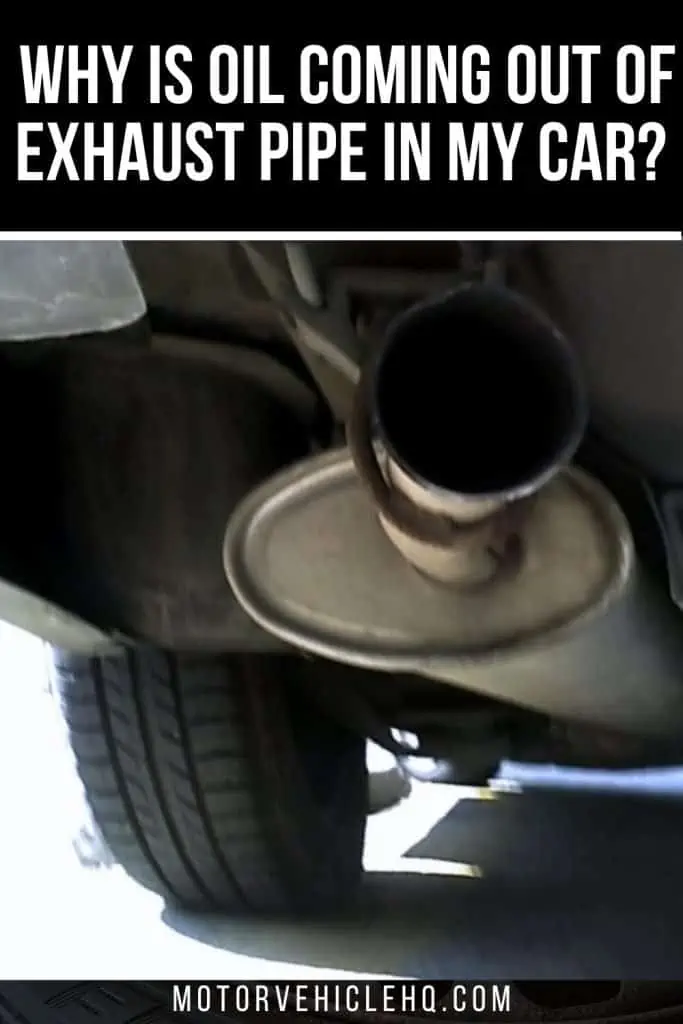Have you seen any dark oil drips recently coming from the exhaust? If this is the case, it should worry you, and you should check the oil level in your vehicle right away.
Because oil coming out of exhaust seems abnormal, the issue has to be fixed right away. We’ll now fill you in on every detail of this issue.
One of the essential fluids that keep your engine running is the engine oil. The engine can’t run without oil. Because there isn’t oil to lubricate the parts and distribute heat, the components would just melt.
Because of this, keeping an eye on the oil level in your internal combustion vehicle is crucial if you don’t want to cause it lasting harm.
However, even though your engine has a secure place to keep the oil. It could yet be able to escape from it. Yes, it is accurate. The oil can leak, leading to a variety of issues that can give car owners a lot of trouble.
Consider diagnosing and fixing the issue of oil coming out of exhaust immediately. This issue requires thorough diagnosis and resolution because it is so significant. Additionally, we’ll describe how to carry out this diagnosis.
Everything you need to know about oil coming out of exhaust will be covered in this post. Starting with the fundamentals, we shall study more about engines and oil. The likely reasons for this issue will then be discussed, followed by advice on how to fix it. So, let’s talk.
What Is Engine Oil, and How Does an Engine Operate?
Your engine functions correctly thanks to the engine oil. Without engine oil, the engine would only be subjected to extremely high levels of friction.
Muffler, and tailpipe on a car by Tusanero~commonswiki / CC BY-SA 2.5. If oil is leaking from your exhaust pipe, probably, some of your car’s oil rings are completely broken or damaged. The oil can’t be contained by these worn-out oil rings, so it just goes through them.
The engine will heat up to melting temperatures as a result of this friction. Many of the interior parts will then become irreparably damaged.
Typically, crude oil was used to make engine oils. However, synthetic materials, which have a considerably higher capacity to lubricate and a lot more durability, are used to make current oils.
Old-fashioned mineral oils didn’t last as long as synthetic oils do nowadays. Fully synthetic oils have a usable lifespan that is greater than the typical life of mineral oils, which is between 5,000 and 7,000 miles.
It is stated that some of these oils may travel more than 15,000 kilometers. However, it is essential to change your engine oil every 5,000 to 7,500 miles just to be cautious.
Regular oil changes can ensure the durability of your engine and keep your costs low. Because getting an engine repaired will cost a lot of money if you have damage.
Simple principles govern how the oil functions. Most internal combustion engines have an oil pan at the bottom where the oil is located.
And once the engine turns over, the oil pump starts to spin, distributing oil throughout the engine. That is how the engine’s lubricating system operates.
But what about the grease I keep getting in my exhaust? We will discuss that issue, as well as the likely circumstances that led to it in the first place, in the chapter that follows.
Why Is Oil Coming Out of Exhaust Pipe?
It is abnormal to see oil coming out of exhaust pipe, and this should cause you to take immediate action to address the issue.
You should, however, be aware of how to confirm that this is oil and not water. The black patches appear whether water or oil has been spilled on the tarmac.
When the vehicle is running, a little amount of water is also expelled from the exhaust. Condensation is the source of this water. And this water may be confused for oil if it mixes with the carbon buildup in your exhaust system.
Therefore, the best course of action in this circumstance is to thoroughly inspect the leaks. Whether the material is oily, check to see if your vehicle is leaking oil from the back. Inspect them with your hand.
Alternatively, if you examine the fluid and it is not oily, it is probably condensation water. It’s an entirely typical problem, especially if you drive in the winter.
Condensation is far more prevalent in the winter than it is in the summer. Therefore, when you start your vehicle, you should prepare for some white smoke and some water to be blasted out of the exhaust.
Additionally, this should warn you if you smell oil coming out of exhaust pipe. The oil level in your car should be the first thing you check. The oil level is a sign that there is a problem with the oil burning.
Examine the level after removing the dipstick. If the level is low, you know you need to add extra oil and investigate the problem. But how exactly do you do that? The following chapter will reveal the answer.

What are the Possible Reasons for Oil Coming Out of Exhaust Pipe?
As we previously stated, you must act to identify the issue if there is oil flowing from the exhaust. What can you do about it, though?
Learning the likely reasons for oil coming out of exhaust should be your first step. We will thus describe all the likely reasons why this issue might arise. This is so that you will know where to search and how to identify this problem.
The next thing we’ll learn is how to diagnose the issue and how much this service will cost. This is because every problem has a distinct price tag.
1. Damaged Head Gasket
One of the first things that may spring to mind when you have an oil-burning issue with your vehicle is a blown head gasket. A head gasket is, however, what?
The head gasket is a unique gasket material used to seal the gap between the engine’s head and block. This head gasket ensures a tight seal, preventing fluids from entering the combustion process and preventing them from mixing.
Depending on where the head gasket leaks after a break, different symptoms will manifest later.
Coolant will leak from the exterior of the gasket material around the block is broken. If the gasket has internal damage, coolant or oil will seep into the engine, leading to oil coming out of exhaust issue.
Alternatively, the gasket may fail midway through. It may enable the mixing of coolant and oil between them. Big sludge will develop from this mixture in your cooling system’s oil.
But because the major subject of this post is oil in the combustion chamber, let’s stick to that issue. How can you tell whether your gasket is letting oil into the combustion process?
Opening the engine is the only method to confirm if this is the case. To check the gasket, the head must be taken off.
After inspection, the issue may be fixed by installing a new head gasket and flushing all the fluids. As the owner, this will ensure that there won’t be any issues in the future or any more oil coming out of exhaust pipe.
2. Damaged O-Rings
Bad O-Rings, or oil rings as they are often called, can result in oil coming out of exhaust issues on your car and cause it to spill oil while you are driving. What, though, are O-Rings?
Your engine’s pistons are fitted with rings made of a unique substance called O-Rings. Their responsibility is to make sure that oil doesn’t leak into the combustion chamber from the oil galley. Your car’s engine will start to have problems and begin to burn oil if the oil escapes through them.
One of the most typical problems with internal combustion engines is the oil-burning issue. The majority of these oil rings are beginning to lose their capacity to contain the oil, which is why this is the situation. A portion of this oil eventually makes it past the oil rings and into the combustion process.
An internal combustion engine by Till.niermann / CC BY-SA 3.0. The engine oil ensures that your engine runs properly. Without engine oil, the friction in the engine would be at an all-time high.
And if you have an issue with oil coming out of exhaust pipe, likely, some of your car’s oil rings are fully shattered or damaged. These damaged oil rings are unable to contain the oil, and it passes right through them.
Your engine is continuously losing oil because the oil is burning, leaving it unlubricated. Additionally damaging the engine will be this oil loss. Therefore, when your engine is burning oil, be careful to frequently fill off the oil and prevent running your engine dry.
Your cylinders may become scarred and other parts of your engine may sustain harm from these shattered oil rings. They’ll probably land in the oil pan.
Later on in this post, we’ll talk about how to detect this problem, but first, let’s have a look at some of the other reasons why it could occur.
3. Damaged Valve Guides
The valve guides may also permit oil to enter the engine, which might result in oil coming out of exhaust issues and ruining your day. What are the valve guides, though?
The valve guides serve as guides for the valve, as their name implies. They are positioned on top of the engine and have a cylindrical form.
Once inside the guides, the valves are checked to see if they are adhering to this geometry by the guides. The valve guide should be rigid and free of play. Only a few tenths of an inch should separate the valve stem from the guide.
But when this separation is greater. The valves are beginning to play and are not properly sealed. This inadequate clearance will let oil enter the cylinder and travel through.
Keep in mind that while the head is placed at the top of the engine, the oil pump is still pumping oil. If there is too much flexibility in the valve guides, the oil will make its way into the cylinders because it needs to go someplace.
And if many cylinders are impacted by this issue, the oil leaks inside the cylinder will, first of all, increase your oil consumption and cause your vehicle to spew oil from the exhaust.
The second issue is the potential for engine damage as a result of the engine’s lack of lubrication from excessive oil burning. In this situation, the key to solving the oil in the exhaust problem is to act quickly. How, therefore, can you carry out this task? Later in the article, we will address it.
4. Damaged Valve Seals
The valve seals are one of the most frequent issues that result in oil leaks into the cylinder from the top side. What are the valve seals, though?
The valve seals do exactly what their name implies, they seal the valves to stop oil from leaking into the cylinder. Typically, these seals are composed of plastic. Additionally, as they age, the engine begins to use more oil as a result of their failure.
You’ll notice that your oil pan is holding less and less oil when the valve seals begin to leak. This is a blatant sign that there is a problem with your engine and that it needs to be looked at.
The valve seals may be easily replaced, but you must conduct this task properly and you will require specialized tools.
Head gasket on the block by Collard / CC BY-SA 3.0. The space between the engine’s head and the block is sealed with a special type of gasket called a head gasket. The tight seal provided by this head gasket prevents fluids from entering the combustion chamber and from mixing.
Additionally, everything needs to be carefully realigned to prevent any potential leaks and engine misfires if the valves are not correctly set.
Your issue with oil coming out of exhaust pipe will be resolved once you replace the valve seals, and your engine should then resume normal operation.
But how can you determine which of the components we named is the issue’s cause and diagnose the issue? Find out in the following chapter.
5. Obstructed PCV Valve
Compared to what travels up the exhaust pipe, crankcase gas is quite pure.
It typically consists of 21% oxygen, 78% nitrogen, and traces of other gases including carbon dioxide and water vapor.
However, there are also trace quantities of oil fumes and unburned gasoline.
Normally, the Positive Crankcase Ventilation (PCV) system removes these gasses and directs them back into the engine for combustion.
However, these vapors will accumulate in the crankcase and ultimately make their way into the exhaust stream if the PCV valve is clogged.
As a consequence, you can see oil coming out of exhaust pipe or coating your muffler, as well as blue or black smoke emanating from your tailpipe.
Even while this is mostly only a bother, if it goes uncontrolled it might eventually cause more significant issues.
Therefore, to stop oil from entering your exhaust system, it’s crucial to have your PCV valve maintained frequently.
6. A Cracked Engine Block or Cylinder Head
Oil can leak out of the exhaust when an engine block or cylinder head fractures. This is due to the break creating a pathway for engine oil to escape.
After mixing with the exhaust gases, the oil will subsequently be released through the exhaust system. In rare circumstances, the oil leak might also enter the combustion chamber, which would result in engine smoke.
A broken cylinder head or engine block can result in significant engine damage if left unattended. As a result, it’s crucial to get any fractures fixed as quickly as possible.
These issues are often more significant, therefore it’s crucial to get your vehicle to a technician as soon as possible so they can perform the required fixes.
How Is Oil Coming Out of Exhaust Diagnosed and Repaired?
This is the crucial thing right now. identifying the issue and potential solutions. If you wish to jump into the troubleshooting waters, this chapter will offer some advice on what you should do next.
Given that the only options entail extensive engine maintenance and disassembling everything, this can also be difficult to accomplish. This is true since many issues are not readily apparent and require a direct evaluation to be fully identified.
PCV valve by Sonett72 / CC BY-SA 3.0. Oil vapors and unburned fuel are removed by the Positive Crankcase Ventilation (PCV) system and then sent back into the engine for combustion. If the PCV valve is blocked, these vapors will build up in the crankcase and eventually enter the exhaust stream.
By doing this, you can avoid spending thousands of dollars on repairs if, for instance, a mechanic misdiagnoses the issue with your vehicle. Because of this, you could attempt completing the repair yourself if the vehicle is outdated or a project.
1. A Damaged Head Gasket
The engine head must be taken off to diagnose a blown head gasket. You must take away all the parts that are sitting on top of the head before you can remove them. The intake, coils, and headcovers are some of these.
To reach the head bolts, all of these parts must be removed. Then, to get the nuts loose, you will need a torque wrench. They are precisely torqued, making it nearly hard to remove them without a torque wrench.
If your engine is a pushrod-style engine, you will also need to remove the rocker arms and rods before you can get the bolts.
The engine head will then need to be removed. The engine head may be set on a table after removal.
Remove the engine block’s gasket and look for any oil leaks there. Good job if you discovered your leak. If only you had remembered to check the oil rings and plunge deeper.
2. Damaged Oil Rings
A significant volume of oil may pass through your broken oil rings and burn inside the cylinder. But how can you tell whether they are reliable?
by following the steps we outlined in the prior chapter. But in this instance, you’ll also need to go over the cylinders to determine whether they require any repairs.
You will undoubtedly want more than just replacement oil rings if they are broken. The block will most likely need to be honed down to eliminate the machine work or scratches.
The pistons must also be taken out and examined. If you spot poor oil rings or missing rings, you’ve identified the offender. You will need to inspect the heads if not.
3. Broken Valve Stems as well as Valve Seals
The valves are the first components you may inspect while disassembling the engine, even though we discuss them last. They are the first to exit the engine, therefore that explains why.
On the combustion side, you must look at the condition of the valves. If you see oil coming out of exhaust pipe, check to see if they have any oil on them and if they are damaged. Oil and carbon would essentially destroy these valves.
The valve guides, valves, and valve seals all need to be replaced in this instance. Additionally, the head must be machined. And this may be quite expensive, but how much? The answer will be revealed in the following chapter.
4. Installing a New PCV Valve
If a clogged PCV valve is to blame, the issue should be resolved by switching out the old one.
Locate the valve, then unplug the hose that is attached to it to replace it. The old valve should then be removed and replaced.
The replacement valve must be fitted in the same direction as the old one, so check that. Finally, screw the hose back into place and reconnect it.
The engine block by 160SX / CC BY-SA 3.0. If an engine block or cylinder head breaks, the oil may seep out of the exhaust. This is a result of the crack providing an exit for engine oil.
Oil should stop escaping from the exhaust once the replacement valve is in place.
5. Fixing or Replacing a Cracked Engine Block or Cylinder Head
A cracked cylinder head or engine block will need to be fixed or replaced if that is the root of the issue.
A broken cylinder head or engine block can be fixable, depending on the magnitude of the fracture.
However, a replacement will be required if the crack is significant or if there are several cracks. Cleaning the area surrounding the fracture to make sure it is clear of dirt and debris is crucial before starting any repair work.
The next step is to decide how to effectively seal the crack once the area has been cleaned. Using a welding procedure is an option for tiny cracks.
However, it could be required to install a metal sleeve into the engine block for severe cracks. The sleeve can be bolted or welded into position once it has been placed.
Before starting the engine, it’s crucial to check for oil leaks and make sure that all of the gaskets and seals are correctly attached.
It should be feasible to effectively fix or replace a damaged cylinder head or engine block by using the techniques listed above.
How Much Does It Cost to Fix the Oil Coming Out of Exhaust Problem?
Depending on the issue, the cost to fix this oil-emitting exhaust issue might change. The head gasket is the least expensive of the many potential culprits of this issue.
A new gasket and head resurfacing will work in this situation. And the cost of this repair will range from $500 to $800, depending on how much resurfacing work is required.
If the existing head is too damaged, another alternative is to acquire a new one. An average head costs $1,000. If you want everything to be flawless, choose this course of action.
If the oil rings are the issue, getting this maintenance done will cost a lot of money. All the bearings and piston rings will need to be replaced as part of a minor engine refresh.
Although the labor is quite labor-intensive and can range from $1,000 to $1,500, the parts are inexpensive. Or, if your engine also has to be machined, you should budget more than $2,000 for the entire project.
Because of this, it makes sense to think about a used engine if you find yourself in this predicament. If a secondhand engine has low mileage, you may be confident that it will function correctly. You never know with rebuilds, though.
If the valves are damaged and there is an oil leak, The only option is to replace the head’s components. A machining shop also performs this.
For a fee of $800, the head will be repaired and made functional. Because a new head costs around $1,000 and is superior to a used head, obtaining a new head is occasionally a possibility.
Cylinder head by Kauczuk / CC BY-SA 3.0. If ignored, a damaged cylinder head or engine block can cause serious harm to the engine. Therefore, it’s imperative to get any fractures treated as soon as possible.
Can You Still Drive with Oil Coming Out of Exhaust Problem?
The majority of the time, a car should be towed to the closest repair shop and taken out of operation as soon as oil begins to seep from its exhaust.
This is because these difficulties are frequently symptoms of far more serious disorders, such as internal engine damage.
Therefore, continuing to drive a car in this condition might do more harm. This can therefore call for a greater investment of time and energy to make the necessary corrections.
Significant engine oil coming out of exhaust pipes also raises the possibility of a fire.
Can Oil Coming Out of Exhaust Pipes Cause a Serious Fire Outbreak?
On a hot exhaust, oil can certainly catch fire. This usually occurs most frequently when the oil gathers on or near an engine’s exhaust manifold, where the hot exhaust is usually located.
But more often than not, the oil will first solder or smoke before igniting into an open flame. The smoke that is created is often blue-gray.
Additionally, the burning smell produced by the overheated engine oil is typically easy to detect. Even passengers in a car can typically smell this stench, especially if the vapors are drawn into the cabin through the fresh-air vents.
How Can You Prevent Oil Coming Out of Exhaust Pipe Issues?
You may take several steps to lessen the likelihood that oil will harm the exhaust system by entering the system.
- Make sure the engine’s oil level is frequently checked and maintained at the proper level.
- Regular engine care, such as tune-ups and oil changes, keeps it operating smoothly and averts build-up that might cause issues.
- Avoid overfilling your oil pan since this can lead to pressure buildup and oil leaking past gaskets and seals.
- Have a trained technician do routine maintenance on your vehicle so they can check all of the seals and gaskets in your engine for wear or damage.
- If you discover any leaks, have them fixed right away to prevent oil from getting into the exhaust system.
You can lessen the likelihood of oil coming out of exhaust pipe and harming your engine by following these easy measures.
The Conclusion
We have discussed a lot of the oil coming out of exhaust pipe issue in this post. After learning how the oiling system functions, we discussed every angle of this problem.
As we previously said, the oil rings, faulty head gasket, valve stems, and seals might all be to blame. When any of these parts malfunction, the oil may enter the combustion and lead to issues.
The procedure of diagnosing has also been discussed, along with the costs associated with having this service done in a shop.
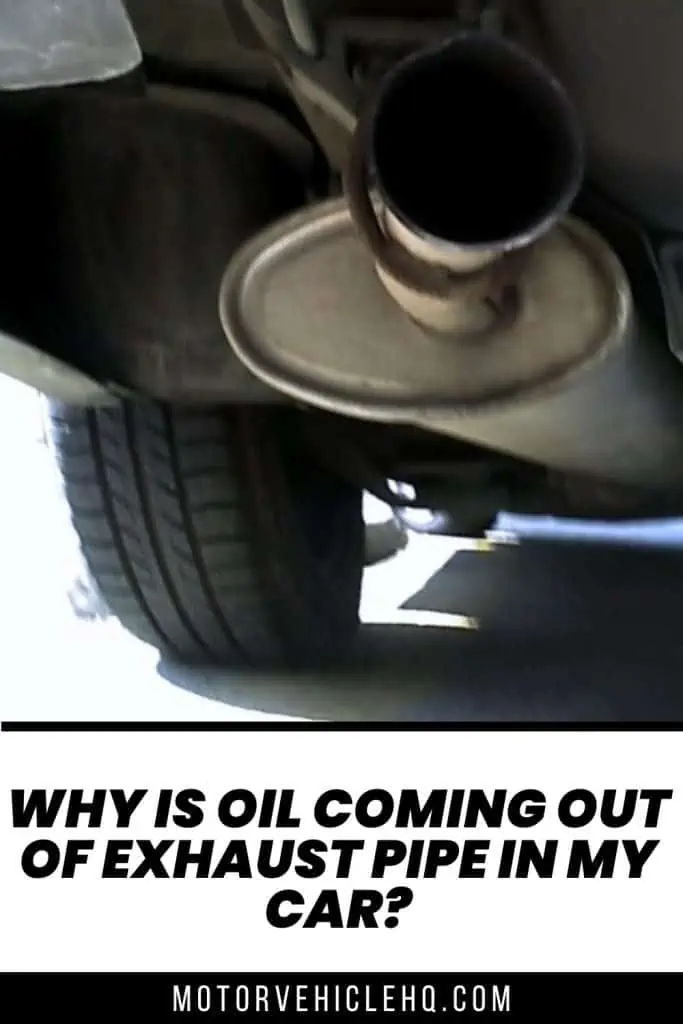
Muffler, and tailpipe on a car by Tusanero~commonswiki / CC BY-SA 2.5

Jim Wicks is the founder of MotorVehicleHQ. With over two decades of experience in the automotive industry and a degree in Automotive Technology, Jim is a certified car expert who has worked in various roles ranging from a mechanic, car dealership manager, to a racing car driver. He has owned more than 20 cars over the past 15 years. Ask him about any vehicle you see on the road and he can tell you the make, model and year. He loves the aesthetics of all things cars, and keeps his vehicles in pristine condition.
In his free time, Jim enjoys getting his hands dirty under the hood of a classic car or taking long drives along the country roads. His favorite car? A 1967 Shelby GT500, a true classic that, according to Jim, “represents the pure essence of American muscle.”
